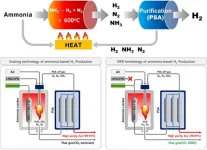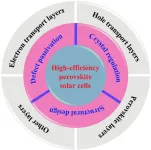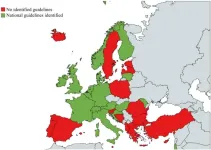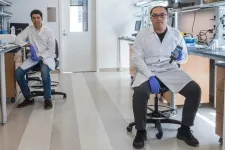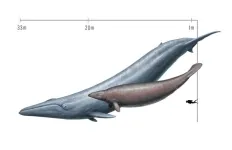(Press-News.org) More than ever before, there is a growing interest in dedicating resources to stop the loss of biodiversity, as recently exemplified by the Kunming-Montreal Global Biodiversity Framework (GBF) decided at COP15 in December 2022. The GBF focuses on understanding why biodiversity is declining and what actions are needed to reverse this trend. However, according to researchers at McGill University, implementing the plan is challenging because information about biodiversity changes is not evenly available everywhere, and is uncertain in many places.
With the available data, can the scientific community and policymakers truly know if they are making progress toward international biodiversity targets, even if their efforts were effective? The research says that without a better picture of how and why biodiversity is changing in most countries, it is difficult to evaluate the effect of national plans outlined in the GBF.
“Even if policies stopped the decline of animal populations, we show mathematically that it will be hard to detect improvements with high certainty, in many places for various types of species (48 of 62 countries and species groups),” explains Prof. Brian Leung from McGill’s Department of Biology and Bieler School of Environment and lead author of the study. “This is because detecting progress is limited by the current levels of uncertainty in the data (the records are either too sparse or too variable) describing animal population trends”.
To further this point, co-author Prof. Andrew Gonzalez compares this issue with monitoring recovery in heart health after an illness. “This would not be easy to do if a doctor had not kept good historical records about a person’s heart health and without good past records, it would be difficult to know if the heart is recovering because of the treatment it is receiving. Now, imagine trying to detect if heart health was improving on average across all Canadians (perhaps by following government recommendations on diet) if data on national heart health was not collected in the past or measured into the future.”
Prof. Gonzalez continues: “instead of heart health we assessed the health of animal populations - how fast they are declining or recovering – and whether we can conclude if populations are recovering worldwide. Tracking biodiversity targets and evaluating progress cannot be done well without filling the gaps in the information at hand and reducing the uncertainty that hinders our ability to evaluate if current trends are improving.”
Measuring efforts across the board
In light of these findings, how should the scientific community and policy makers evaluate their efforts to meet such ambitious goals like preserving 30% of land and water by 2030 and slowing the rate of human-caused species extinctions? The researchers make several suggestions, including proposing a risk framework that would establish unacceptable thresholds for biodiversity decline, which are easier to detect. Also, the authors suggest investment in a national and international biodiversity monitoring systems to improve trend estimates worldwide.
As Prof. Leung concludes: “Our results highlight that care must be taken to structure how we gather knowledge about biodiversity, so that we will be able to report whether we have succeeded in meeting our global targets given international investment in nature conservation or alternatively, whether we need to re-orient our actions.”
In summary, these recommendations put forward a more rigorous approach to interpreting biodiversity trends, incorporating risk considerations, boosting investment in monitoring, explicitly deciding thresholds for success, and the use of reference benchmarks to make informed conservation decisions. If implemented, many countries potentially could benefit, given the international reach of the GBF.
About the study
“Global monitoring for biodiversity: uncertainty, risk and power analyses to support trend change detection” by Brian Leung and Andrew Gonzalez was published in Sciences Advances.
END
Uncertainty in measuring biodiversity change could hinder progress towards global targets for nature
Researchers find it could be difficult to detect biodiversity improvements due to conservation action for nature and suggest practical solutions to guide conservation
2024-02-29
ELSE PRESS RELEASES FROM THIS DATE:
Zero emissions of carbon dioxide! Successful production of ammonia-based clean hydrogen
2024-02-29
Dr. Jung Unho's research team at the Hydrogen Research Department of the Korea Institute of Energy Research (KIER) has developed Korea's first clean hydrogen production technology. This technology is based on ammonia decomposition and does not use fossil fuels. The team's breakthrough could pave the way for a more sustainable and eco-friendly energy source. This allows for the production of high-purity hydrogen that meets international standards for hydrogen-powered vehicles, without the carbon dioxide emissions produced by using fossil fuels.
Ammonia, a compound of hydrogen and nitrogen, has a hydrogen storage density 1.7 times ...
Guiding future research on ‘extraordinary potential’ of next-generation solar cells
2024-02-29
Today’s commercial solar panels can convert about 15% to 20% of the sunlight they absorb into electrical energy — but they could be much more efficient, according to researchers at Soochow University. The next generation of solar cells has already demonstrated 26.1% efficiency, they said, but more specific research directions are needed to make such efficiency the standard and expand beyond it.
They published their review of the current state of research on high-efficiency perovskite solar cells and their recommendations for future work in Energy Materials and Devices on February 4.
“Metal halide perovskite ...
Urgent need for guidelines for the care of child victims of sexual abuse
2024-02-29
Only half of 34 surveyed European countries have national guidelines on how to provide clinical care and treatment to children who have experienced sexual abuse. This finding was revealed in a study led by researchers at Barnafrid, a national knowledge centre in the field of violence and other abuse against children, at Linköping University in Sweden. The consequences for the affected children can be severe, according to the researchers.
“Our findings suggest that children in Europe may not receive equal care. From a child rights perspective, this is unacceptable. ...
Overcoming barriers to conducting clinical trials in childhood rare disease research
2024-02-29
Using a novel methodology, researchers at The Hospital for Sick Children (SickKids) are the first in paediatric research to use data from an international real-world cohort to overcome the barriers associated with conducting randomized clinical trials in children with rare diseases.
The gold standard for evaluating new therapeutics is through randomized clinical trials, where one group of individuals receives treatment while another does not. Unfortunately, conducting this type of clinical trial proves challenging for many rare conditions due to the limited number of individuals with the condition, making meaningful comparisons difficult. Additionally, ...
Faster and simpler point-of-care malaria test developed by Rice researchers
2024-02-29
Rice University researchers have developed a rapid, accurate test for diagnosing malaria that is significantly faster and easier to use than traditional tests. The advancement has the potential to improve patient outcomes, especially in rural regions with limited health care resources.
Malaria remains a significant global health challenge with an estimated 247 million cases and more than 600,000 deaths annually, the majority of which occur in sub-Saharan Africa. The most severe form, cerebral malaria, has a high mortality ...
Investigating cell killers: Advanced system for size-dependent cytotoxicity analysis of silica
2024-02-29
Metal nanomaterials have become an indispensable part of industrial and medical fields due to their unique and versatile properties. Their size, which imparts them with the desired physiochemical properties, is also the reason for environmental and health concerns. The nano-sized particles in nanomaterials have shown high reactivity towards biomolecules and often even toxicity towards biological cells.
Scientists have attributed this behavior of metal nanoparticles in interaction with biomolecules to phenomena like inflammation or oxidative stress. However, to ensure the safe usage of metal nanoparticles, ...
Poor spatial navigation could predict Alzheimer’s disease years before the onset of symptoms
2024-02-29
People at risk of Alzheimer’s disease have impaired spatial navigation prior to problems with other cognitive functions, including memory, finds a new study led by UCL researchers.
The research, published in Alzheimer’s & Dementia: The Journal of the Alzheimer’s Association, used virtual reality to test the spatial navigation of 100 asymptomatic midlife adults, aged 43-66, from the PREVENT-Dementia prospective cohort study.
Participants had a hereditary or physiological risk of Alzheimer’s disease, due to either a gene (the APOE-ε4 allele) that puts them at risk of the condition, a family history of Alzheimer’s disease, ...
Black mountain unveils fossil trove
2024-02-29
A team of researchers led by Alexander Pohle has unveiled a treasure trove of ancient fossils from Queensland's Black Mountain. The findings, published in PeerJ Life & Environment, shed new light on the complex three-dimensional siphuncle morphology of Plectronoceratids, a pivotal group of molluscs from the latest Cambrian period.
The study surpasses the entirety of previously documented Plectronoceratid fossils, presenting over 200 well-preserved specimens. These fossils, meticulously collected by the late Mary Wade and her team during the 1970s and 1980s, offer unprecedented insights into the intricate structures of these ancient creatures.
Pohle's team focused on specimens ...
Slimming down a colossal fossil whale
2024-02-29
A 30 million year-old fossil whale may not be the heaviest animal of all time after all, according to a new analysis by paleontologists at UC Davis and the Smithsonian Institution. The new analysis puts Perucetus colossus back in the same weight range as modern whales and smaller than the largest blue whales ever recorded. The work is published Feb. 29 in PeerJ.
A fossil skeleton of Perucetus was discovered in Peru and described in a paper in Nature last year. The animal lived about 39 million years ago and belonged to an extinct group of early whales called ...
Better neutron mirrors can reveal the inner secrets of matter
2024-02-29
Improved neutron mirrors can increase the efficiency of material analysis in neutron sources such as the ESS, which is being built outside Lund, Sweden. The improved mirror has been developed by researchers at Linköping University by coating a silicon plate with extremely thin layers of iron and silicon mixed with boron carbide. Their study has been published in the journal Science Advances.
“Instead of increasing the power on the neutron source, which is extremely expensive, it’s better to focus on improving optics,” says Fredrik Eriksson, researcher at the Thin Film Physics Division at Linköping University.
Together with protons, neutrons ...
LAST 30 PRESS RELEASES:
School meals could unlock major gains for human and planetary health
Menopause hormone therapy does not appear to impact dementia risk
Signature patterns of brain activity may help predict recovery from traumatic brain injury
Dresden study uncovers new key mechanism in cancer cells
New species are now being discovered faster than ever before, study suggests
Cannabis-based products show limited short-term benefit for chronic pain, with increased risk of adverse effects
Cannabis products with more THC slightly reduce pain but cause more side effects
Clearing the brain of aging cells could aid epilepsy and reduce seizures
Brain injuries linked with potential risk of suicide, new study finds
New technique lights up where drugs go in the body, cell by cell
New study finds movement of fishing fleets can reveal shifts in marine ecosystems
Embargoed: New evidence points to potential treatment for vascular dementia
Study uncovers disrupted brain balance in alcohol dependence
Working in groups can help Republicans and Democrats agree on controversial content moderation online
Structural findings reveal how distinct GPCR ligands create different levels of activation
Anything-goes “anyons” may be at the root of surprising quantum experiments
UC review: Maximizing workplace opportunity for veterans
From generation to complex control: Metasurfaces make perfect vortex beams "within reach"
Thin-film lithium niobate-based detector: recent advances and perspectives
Exploring why some people may tend to persistently make bad choices
How cells balance their protein levels
Nirsevimab vs RSVpreF vaccine for RSV–related hospitalization in newborns
Effectiveness and impact of maternal RSV immunization and nirsevimab on medically attended RSV in US children
AI gives scientists a boost, but at the cost of too many mediocre papers
Next-generation vision model maps tree growth at sub-meter precision
Genes aren’t destiny for inherited blindness, study shows
MIT study: High-fat diets make liver cells more likely to become cancerous
Exposure to multiple fine particulate matter components and incident depression in the US Medicare population
Risk of burdensome health care spending over time in the US
Nirsevimab against hospitalizations and emergency department visits for lower respiratory tract infection in infants
[Press-News.org] Uncertainty in measuring biodiversity change could hinder progress towards global targets for natureResearchers find it could be difficult to detect biodiversity improvements due to conservation action for nature and suggest practical solutions to guide conservation
